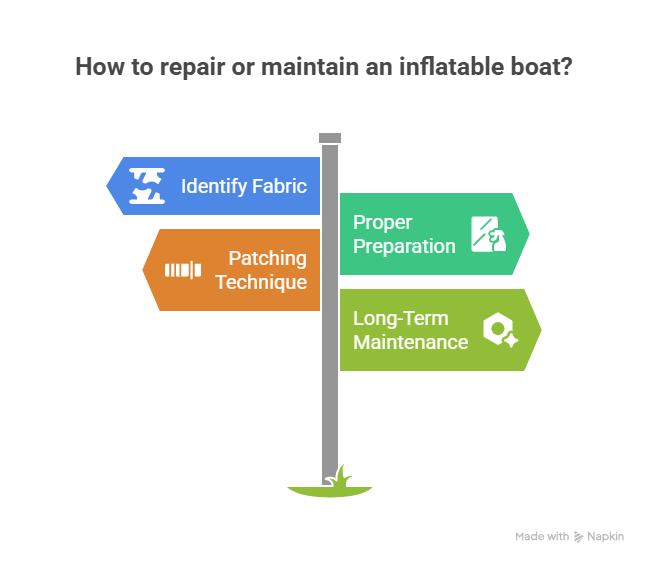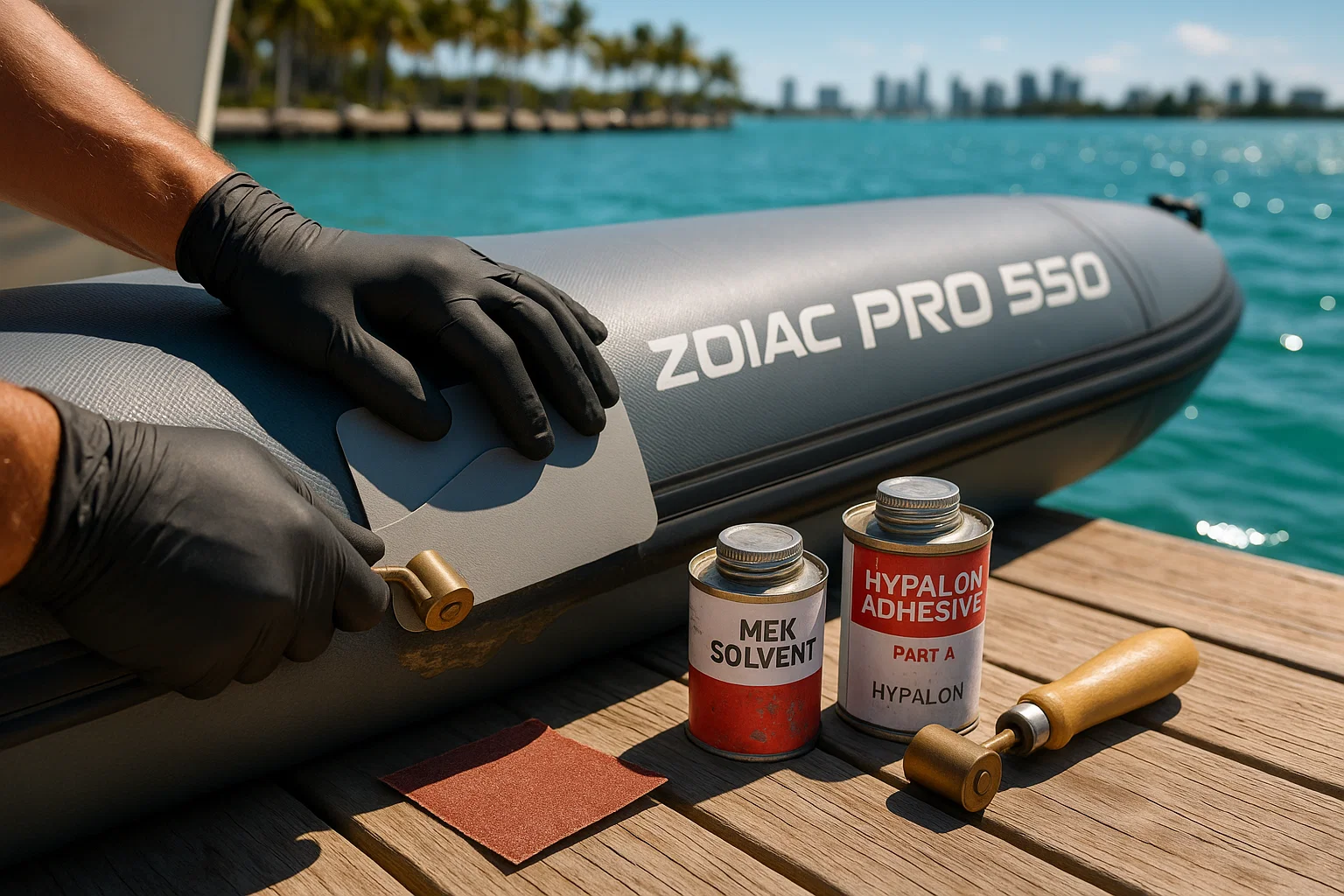I’ve been patching inflatable boats in South Florida for 15 years, and trust me, I’ve seen every kind of tear, puncture, and seam leak you can imagine. Last July, a guy named Carlos rolled into Dinner Key Marina with his Zodiac Pro 550, cursing a gash that ruined his weekend. I fixed it in an hour with a double patch—cost him $200 instead of a $1,500 tow. Inflatable boat repair isn’t just about slapping on glue; it’s about knowing your boat’s fabric, prepping like a pro, and not rushing the cure. Here’s my guide to nailing inflatable boat repair so you’re back on the water fast.
Table of Contents
Why Do Inflatable Boats Get Damaged?
Miami’s sun, saltwater, and sharp docks are brutal on inflatable boats. UV rays bake the fabric brittle, salt corrodes seams, and one bad scrape can leave you deflated—literally. I’ve seen 90% of patch failures come from sloppy prep, not bad materials. Get the prep right, and your inflatable boat repair will hold for years.
What’s Your Boat Made Of?
The first step in any inflatable boat repair is knowing your fabric: PVC or Hypalon. They’re like oil and water when it comes to glue. Last summer, a client at Key Biscayne tried PVC adhesive on his Hypalon RIB—patch peeled off in a week. Here’s how to tell them apart:
- Sanding Test: Sand a hidden spot. PVC scuffs but stays the same color; Hypalon sands to a dark, dusty layer.
- Seam Check: Welded seams scream PVC; glued overlaps mean Hypalon.
- Check the Manual: Google your boat’s model for the surefire answer.
Using the wrong adhesive? You’re wasting your time.
How to Prep for a Rock-Solid Inflatable Boat Repair?
Before you touch the glue, prep is king. I learned this the hard way in 2010 when a rushed patch on a customer’s Achilles at Stiltsville failed mid-trip—embarrassing. Here’s my go-to prep checklist:
- Find the Leak: Spray soapy water on the inflated tube and look for bubbles. Circle the spot with a marker.
- Gather Your Kit: I keep a waterproof bag with patch fabric (PVC or Hypalon), two-part marine adhesive, solvent (MEK for PVC, Toluene for Hypalon), 80-grit sandpaper, a glue brush, and a seam roller. Nitrile gloves and safety glasses are non-negotiable.
- Clean and Sand: Wipe the patch and boat with solvent, sand lightly, then clean again. Don’t touch the surfaces after.
Prep takes 20 minutes but saves you from a $500 pro job.

How to Patch a Puncture Like a Pro?
Most inflatable boat repairs are simple punctures or abrasions. Follow these steps, and your patch will outlast the boat.
Step 1: Cut and Clean
Deflate the chamber. Cut a circular patch 2 inches bigger than the hole all around—bigger for tears. Trace the patch on the boat with a marker, mask the edges with tape for a clean look. Clean both surfaces with solvent, sand lightly, and wipe again. I fixed a pinhole on a West Marine dinghy last month this way—still holding strong.
Step 2: Glue and Set
Mix your two-part adhesive per the label. Brush a thin coat on the patch and boat, wait 5–15 minutes until tacky, then apply a second coat. Wait until it’s tacky again, then press the patch on, working from the center out to kill air bubbles. Roll it hard with a seam roller—or a spoon’s back if you’re in a pinch. This ensures a 100% bond.
Step 3: Cure and Test
Let the glue cure for 24–72 hours, depending on the adhesive and Miami’s humidity. Rush this, and you’re screwed. After curing, inflate to the manufacturer’s PSI (usually 3–15 PSI) and do the soapy water test again. I patched a client’s Intex Mariner at Bahia Mar last June—zero leaks after a year.
What About Tricky Repairs Like Seams or Big Tears?
Punctures are easy; seams and gashes test your patience. Here’s how I tackle them without losing my mind.
How to Fix a Leaky Seam?
Seams are stress points, and bubbles there mean trouble. Last April, a buddy’s Highfield at Coconut Grove had a seam leak. I used seam tape: cut a strip 3 inches past the leak on both sides, cleaned with Toluene (it was Hypalon), and glued it like a standard patch, pressing extra hard into the seam’s curve. Held up through a stormy summer.
How to Handle a Big Tear?
Big tears need a double patch—inside first, then outside. I fixed a 6-inch gash on a Brig Eagle at Fort Lauderdale’s marina last year. Fold an internal patch, slip it through the tear, glue it to the inside (tricky but doable), and let it cure. Then patch the outside as usual. It’s a $300 fix instead of a $2,000 replacement.
When to Call a Pro?
Some inflatable boat repairs are beyond DIY. If the tear’s over 8 inches, hits an internal baffle, or involves the transom detaching, call a pro. Same for leaks under fittings—I’ve seen guys botch those and sink their boats.
How to Keep Your Boat Leak-Free Long-Term?
The best inflatable boat repair is the one you never do. These habits keep my Boston Whaler dinghy leak-free for a decade.
Rinse and Inspect
Rinse with fresh water after every saltwater trip—Miami’s salt eats fabric. Wash monthly with mild soap, feeling for abrasions or loose seams. I caught a seam lift on a client’s Saturn at Key Biscayne last spring—fixed it before it leaked.
Don’t Over-Inflate
Use a pressure gauge to hit the manufacturer’s PSI. Over-inflating on a 90°F day stresses seams. I saw a guy’s Walker Bay pop a seam at Stiltsville—$800 fix.
Block UV Damage
Florida’s sun is a fabric killer. I spray 303 Aerospace Protectant every month and cover my boat at the dock. Saved me thousands in inflatable boat repairs.
Comparison Table: My Inflatable Boat Repair Toolkit
I threw this table together from jobs I’ve done in South Florida:
| Tool/Material | Use Case | Cost | Availability |
|---|---|---|---|
| PVC/Hypalon Patch | Covering punctures or tears | $10–$30 | Marine stores, online |
| Two-Part Adhesive | Bonding patches to PVC or Hypalon | $20–$50 | Specialty retailers |
| MEK/Toluene Solvent | Cleaning surfaces for prep | $15–$25 | Hardware stores |
| Seam Roller | Ensuring 100% patch contact | $10–$20 | Marine suppliers |
| 303 UV Protectant | Preventing UV damage | $15–$30 | Online, marine shops |
FAQ: Common Inflatable Boat Repair Questions
How do I know if my boat is PVC or Hypalon?
Sand a hidden spot—PVC scuffs, Hypalon turns dusty. Check seams: welded for PVC, glued for Hypalon. Or Google your model’s specs. I misjudged a client’s RIB once—wasted $50 on wrong glue.
How long does an inflatable boat repair take?
Prep and patching take 30–60 minutes, but curing needs 24–72 hours. I fixed a Zodiac’s puncture at Dinner Key in an hour, but it sat for two days before use.
Can I use regular glue for inflatable boat repair?
No way. Use two-part marine adhesive for your fabric type. Regular glue fails fast—I saw a guy’s DIY patch peel off in a week at Bahia Mar.
How do I find a leak in my inflatable boat?
Spray soapy water on the inflated tube and watch for bubbles. Mark the spot. I found a pinhole on a client’s Intex at Coconut Grove this way—took 5 minutes.
How often should I do inflatable boat repair maintenance?
Rinse after every saltwater trip, wash monthly, and spray UV protectant every 1–2 months. I do this for my dinghy—zero leaks in 10 years. Try 303 Protectant for UV defense.
When should I hire a pro for inflatable boat repair?
Call a pro for tears over 8 inches, baffle damage, or transom issues. I referred a client’s Brig to a shop last year—saved him from a botched $2,000 job.
How do I prevent UV damage to my inflatable boat?
Spray 303 Aerospace Protectant monthly and use a cover at the dock. I’ve avoided major inflatable boat repairs on my boat with this routine. Check marine stores for 303.
Conclusion
Mastering inflatable boat repair means you’re never stuck cursing a leak mid-trip. It’s about prepping like a pro, matching your glue to your fabric, and giving the adhesive time to cure. My years fixing boats at Miami’s marinas taught me that 90% of failures come from rushing or skipping steps. Build your repair kit now—patch fabric, adhesive, solvent, tools—and you’ll turn a crisis into a quick fix. Your boat’s your ticket to adventure. Keep it ready with these skills, and you’ll hit the water with confidence every time.
Author Bio
I’m Alex, a 15-year marine technician in South Florida, specializing in inflatable boat repair. I’ve patched 200+ boats, from Zodiacs to Intex, across Miami and Fort Lauderdale. ABYC-certified and obsessed with keeping boats afloat.


Leave a Reply